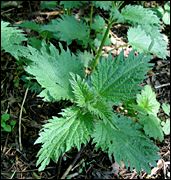Whether you accept it, avoid it or live somewhere in between, insurance coverage has become a defining issue for our profession. Patients increasingly expect to use their benefits, practitioners want to be compensated fairly for their time and expertise, and the system itself remains – at best – fragmented. The encouraging news is that coverage has expanded in meaningful ways. The challenging news is that reimbursement, across the board, remains inadequate.
Herbs & Botanicals
Urtica (xun ma)
What is urtica? What is it used for?
Urtica is the name given to two types of round, green bushes found throughout the world. Fully grown, urtica bushes can reach a height of three feet. The plant is more commonly known as the stinging nettle, and has gotten that nickname from the small hair-like projections that cover it, especially the leaves and stem. The hairs of the urtica plant contain chemicals inside them that irritate a person's skin and can be quite painful to the touch.
Traditionally, urtica has been used to stimulate circulation. Many cultures have used branches of the urtica plant as part of a whipping technique called flagellation, which allegedly activates paralyzed muscles and stimulates organs. In previous centuries, it has also been used to treat a variety of conditions, ranging from rheumatism and eczema to arthritis, gout and anemia.
 Today, urtica is most commonly used to treat urinary problems associated with the early stages of an enlarged prostate gland. The German Commission E has approved the internal use of urtica leaves and stems for inflammatory diseases of the lower urinary tract and to prevent kidney stones. It also, and has diuretic effects if taken with enough fluid. Urtica leaves have sometimes been employed as a topical compress or cream for gout, sprains, sciatica, tendonitis, burns, hemorrhoids and insect bites.
Today, urtica is most commonly used to treat urinary problems associated with the early stages of an enlarged prostate gland. The German Commission E has approved the internal use of urtica leaves and stems for inflammatory diseases of the lower urinary tract and to prevent kidney stones. It also, and has diuretic effects if taken with enough fluid. Urtica leaves have sometimes been employed as a topical compress or cream for gout, sprains, sciatica, tendonitis, burns, hemorrhoids and insect bites.
How much urtica should I take?
For lower urinary tract inflammation and kidney stones, many practitioners recommend between 8-12 grams of tea made from urtica leaves, along with at least two liters of liquid a day. For enlarged prostate conditions, 4-6 grams of root tincture (1:10 ratio) daily is recommended. Remember to consult with a licensed health care provider first before taking urtica for prostate or urinary problems.
What forms of urtica are available?
Urtica is available in the form of dried leaves, which can be crushed and used in teas or capsules. Tinctures containing urtica root are also available (a tincture is a solution of the herb in alcohol).
What can happen if I take too much urtica? Are there any interactions I should be aware of? What precautions should I take?
Urtica is safe when used as directed; however, excessive use may interfere with the actions of hypoglycemic, hyperglycemic, antidiabetic and depressive drugs. If your skin touches the plant, you may feel a stinging sensation or contract hives.
In addition, urtica may alter a woman's menstrual cycle. Women who are pregnant or nursing should not take urtica products and should contact their health care provider with any questions or concerns. As always, make sure to consult with a licensed health care practitioner before taking urtica or any other herbal remedy or dietary supplement.
References
- Belaiche P, Lievoux O. Clinical studies on the palliative treatment of prostatic adenoma with extract of urtica root. Phytotherapy Research 1991;5:267-269.
- Chrubasik S, Enderlein W, Bauer R, et al. Evidence for antirheumatic effectiveness of herba urticae dioica in acute arthritis: A pilot study. Phytomedicine 1997;4:105-108.
- Krzeski T, Kazon M, Borkowski A, et al. Combined extracts of urtica dioica and pygeum africanum in the treatment of benign prostatic hyperplasia: double-blind comparison of two doses. Clin Ther 1993;15:1011-1020.
- Oliver F, Amon E, Breathnach A, et al. Contact urticaria due to the common stinging nettle (urtica dioica) - histological, ultrastructural and pharmacological studies. Clin Exp Dermatology 1991;267:1-7.
- Schulz V, Hänsel R, Tyler VE. Rational Phytotherapy: A Physician's Guide to Herbal Medicine, 3rd ed. Berlin, Germany: Springer-Verlag; 1998:228-238.


